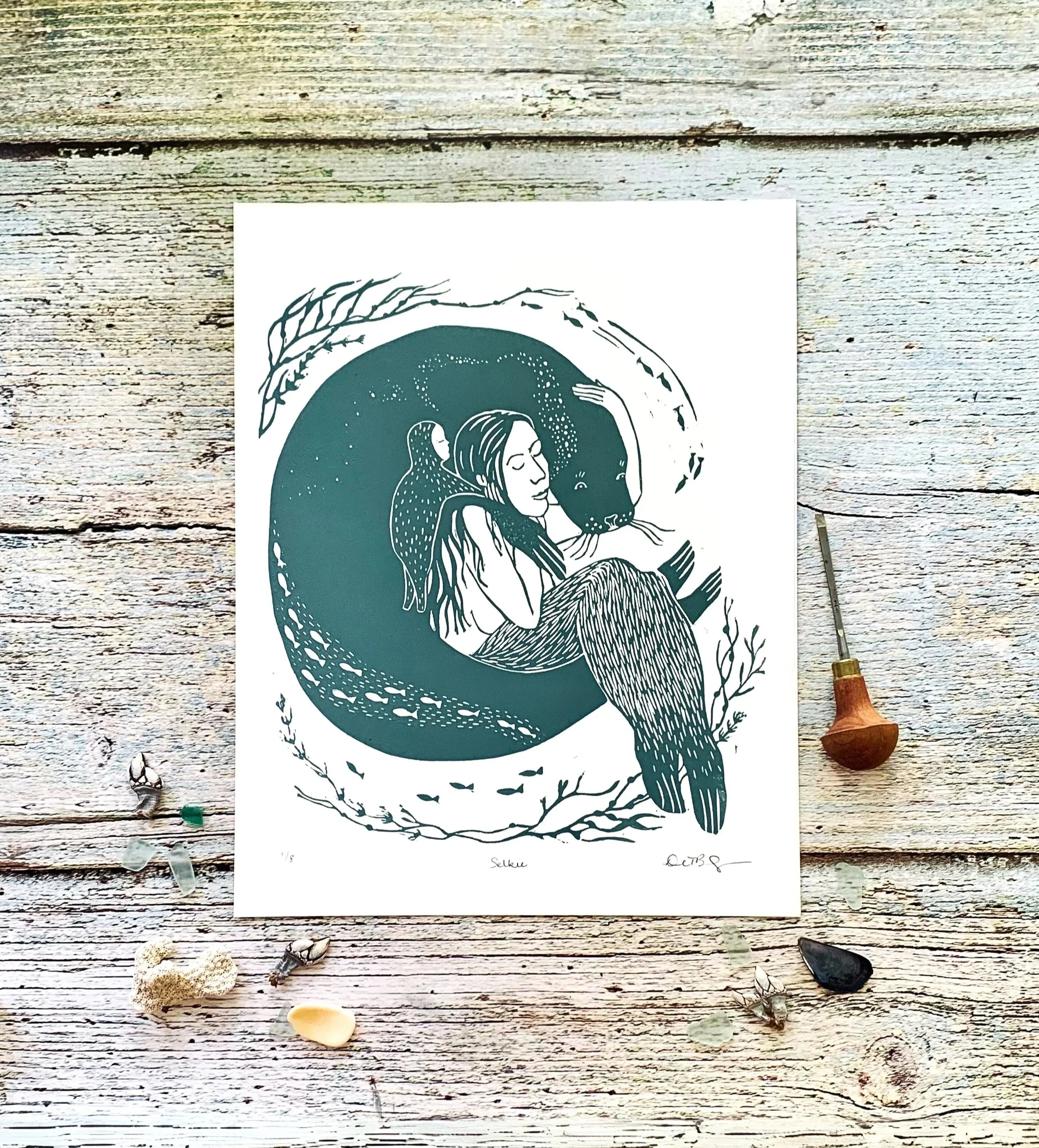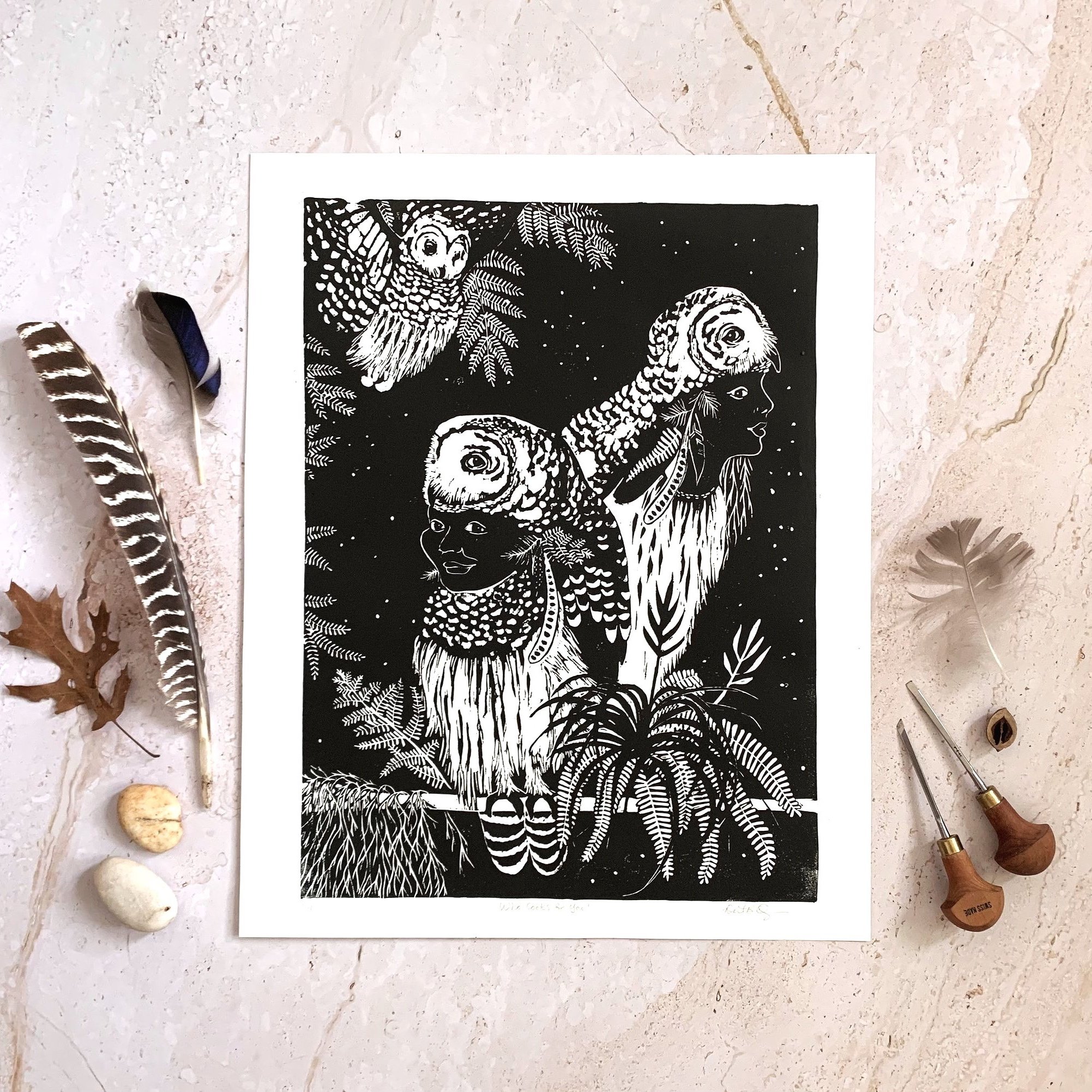Gallery: Monochrome linocuts
HARE MOON MAGIC
Bridging the celestial and the earthly, women and the wild, this archetypal trio weaves its way through our interconnected human roots from China to the Middle East, to Europe, Africa and the Americas. The energy of this ancient folklore trio holds us together and roots us in the enchantment of this shared cultural synchronicity, and the mystery of what endures . . .while the world goes through its phases.
Selkie
A splash of grey flippers, the salty smell of sea kelp, and a fierce sense of belonging to an underwater world are the beating heart of this beloved Irish, Icelandic and Scottish folktale about a seal-woman who loses her pelt to her lover, and how she finds it again. Selkie is a story about a heroine who reclaims her soul revealing the deep entwinement between love and grief, separation and belonging that is as complex and salty as the sea itself.
Mother Goose
Old Mother Goose, an ancient Germanic folk heroine as powerful as nature itself, is thought to shapeshift between an elderly woman and a snow goose. Intimately entwined with this wild migratory bird, in some versions of the story she has one large foot, like that of a goose, perhaps a splayed foot from pressing the treadle of her spinning wheel, representing the cycle of life, death, and rebirth as well as seasonal changes.
SkyWoman
Sky Woman is a Haudenosaunee creation story about the first woman, an outsider, an immigrant, a celestial stranger who falls from the sky into the world of earthly creatures. Sky Woman shows us the power of reciprocity to bridge differences, and the abundance everyone receives when two worlds meet, and how generosity is the first act that brings the world, Turtle Island, into being.
Athena
Athena, the Greek Goddess renowned for her Wisdom, had an intimate relationship with a wounded Little Owl whom she first meets in a forest. The story suggests wisdom comes from having more than one perspective, requiring double sightedness, and a deep relationship between the human and more-than-human worlds. It is also a story about how to cultivate wisdom from suffering.
Raven Goddess
The Celtic Morrigan, Slavic Morana, and Hindu Dhumavati are entwined through the dark wings of the raven. Their aerial point of view gifts them with wisdom to see the whole. Witch and winged-one in sacred kinship, their black feathers stitch together life and death, winged and earthbound, mortal and divine, seen and unseen. What modern spell is broken when we unearth the lore and lure of this ancient sisterhood of raven goddesses from distant landscapes who circle the same sky?
Three Sisters
The North American indigenous folktale of the Three Sisters is celebrated from Mexico to Montana, and teaches the ancient agricultural technique of planting corn, beans and squash together because each provides some benefit to the others’ growth and health. The Three Sisters celebrates a sisterhood of mutual thriving where each sister’s uniqueness is celebrated and recognized as important to the health of the whole: ancient wisdom we can harvest and each year if we choose to listen and learn from the plants.
Fox Woman
Fox Woman, also known as Kitsune in Japanese folklore, is a shapeshifting trickster character who resembles the elusive, clever fox from the wild. Although this folktale comes in many different variations and her story is told in many tongues, what they all have in common is a trickster character who shifts between human and fox, living in multiple worlds, questioning the order of things through her mischief, playfulness, wit, deception, magic and defiance of authority. Fox Woman is almost always a tale of transformation and self-discovery, making visible the tension between the need for order, and its reinvention.
The Weaver of the World
Like the concept of Yin and Yang, the folkloric archetype of opposing forces that create the cosmos, weaves its way into so many different landscapes and cultural traditions secretly behind a veil of different stories and visual motifs . . and here it is hidden in plain sight, in the White Mountain Apache folktale of The Old Woman Who Weaves Together the World and the Black Crow who pecks at the loose ends and unravels it again. Inspired by Michael Meade’s retelling of this story in his book Why the World Doesn’t End: Tales of Renewal in Times of Loss.
SELKIE
The ocean’s oldest and saddest stories are preserved in the brine of saltwater sorrow that serves as a salve transforming grief into something we can bear to hold, and the Celtic tale of the Selkie is one of them. A seal-woman’s pelt is stolen by human and she is held captive on land with the man whose child she bears. Until one day she reclaims her skin and returns to her home in the sea trusting the child will one day learn to swim between worlds. Selkie is a story of a salt-stung wound that the sea cradles into song. . .
Dragon & Crane
The love story between a dragon and a crane is one of many endearing folktales that make up Vietnam’s rich heritage of maritime folklore. The enduring wisdom of this story is about finding the hidden treasure that is birthed from unexpected connections, and when we choose to come together despite our differences. Retold by Thích Nhất Hạnh in his book A Taste of Earth and Other Legends of Vietnam.
Baba Yaga & The Falcon
Baba Yaga is the enduring enigmatic powerful female wilderness creatrix and crone from Russian folklore. Baba Yaga often appears straddling the line between the benevolent and the malevolent. She is typically portrayed as an old witch and guardian of the forest who lives in a hut that stands on chicken legs. She is a keeper of wisdom, often serving as a guide or obstacle to those who seek her assistance. Her stories frequently explore themes of survival, transformation, and the duality of nature.
Wolf Totem
In the heart of Mongolia wolves and sheep herders once lived in harmony with each other. Though wolves were regarded as an "enemy" and often killed the sheep these nomadic herders depended on for their livelihood, wolves also modeled strategies of survival that herders adopted enabling them to live for generations in the harsh landscape. The wolves were revered as a divine teachers, protective spirits of the grasslands, and the ultimate ones who carried human souls to the other world after death. . .a profound way practical survival and mythology work in tandem to weave together wolves and humans in this world and the next.
Bird Woman
Inspired by aerial women and bird women featured in folktales throughout the world. Whether it is the Norse Valkyries, or the Egyptian celestial goose mother of all Creation Gengen-Wer, or Hindu apsaras, there is an enduring and persistent relationship between birds and a sense of fierce and powerful womanhood and femininity. Inspired by the book Women Who Fly: Goddesses, Witches, Mystics and other Airborne Females by Serenity Young.
Pretty Pearl
Inspired by Virginia Hamilton’s The Magical Adventures of Pretty Pearl, where the forest is a sanctuary for fugitives who hide from a world that would otherwise enslave them. A story where an intimate and enchanted relationship with wild birds and folk magic offers a source of resilience to survive one of the most horrifying periods in history.
Crescent Moon Bear
A Japanese (indigenous Ainu) folktale about a wife’s courageous effort to reconnect with her husband who has returned from war a changed man. Under the guidance of a shaman, she undergoes a quest to pluck the whisker of a crescent moon bear and discovers inside herself the patience, resilience and courage she needs to find a way to reconcile with the man she loves. The story points to how the real marriage is the heroine’s relationship with the parts of herself she had outcast, and how embracing them transforms how she relates to the outside world.
The Mitten
A folktale about the importance of generosity when faced with scarcity of resources that can be found in both Ukrainian and Abenaki folklore. In the Ukrainian version, woodland animals try to fit into a mitten for warmth though it is too small. In the Abenaki version they are all coerced into a bag to feed a hunter even though taking all of them exceeds the hunter’s needs. Myths and stories that reveal shared values despite having originated from different cultures and landscapes reveals an undercurrent of synchronicities that connects us all together.
Linnunraata
Inspired by a Finnish folk astronomy story that envisions the Milky Way as the migratory path of wintering birds, who are thought to be “soul carriers” at the moment of birth and when one dies. A folkloric way of meaningfully framing the relationship between humans and the wild as one of deep kinship. Linnunraata reminds us of our own belonging to the world, folding us back into the feathered wings of a universe that mothers us.
The owl Lover
An endearing love story about a rare white Great Horned Owl who falls in love with a human woman, retold by Joseph Bruchac in his book Wabi: A Hero’s Journey. This Abenaki folktale suggests that nature is courting us, that there is a romance taking place. . .a precious mythos from ancient times about the intimate and tender relationship between humans and the wild.
Makers of Dreams
“Makers of Dreams” is inspired by a heartwarming folktale from the Isle of Skye beautifully retold by Scottish Storyteller Daniel Allison in his book Scottish Myths and Legends. It is about a young girl who gets lost in the mountains and unexpectedly discovers The Dreammakers. . an elderly couple who make dreams out of deer cheese. It is the wild birds who carry these dreams to different landscapes where they nestle into the heads of those who sleep. Included in this piece are feathers of a snow goose, merlin, osprey, crow, snowy owl, bald eagle and peregrine falcon, a herd of deer, the dramatic spiky pinnacles of The Old Man of Storr, and the Makers of Dreams.
Who Cooks For You?
Who Cooks for You is inspired by an African American folktale retold by Virginia Hamilton in her book Her Stories, African American Folktales, Fairytales and True Tales. The story is about three women who turn into owls with themes of freedom, transformation and rewilding the Self.
Jade Rabbit
What stirs the soul more deeply than the quintessential pairing of rabbits and the moon? Reflecting on the ancient Chinese Jade Rabbit on the Moon folktale, we discover the timeless enduring medicine the Jade Rabbit is entrusted to safeguard on the moon and how it serves as a timeless healing salve in a contemporary world fraught with divisiveness and tension.
Polar Bear Son
Polar Bear Son is a deeply moving Inuit folktale with themes of reciprocity and interdependence, ancient wisdom still relevant in contemporary times. An elderly woman raises an abandoned baby polar bear as her son. When she grows too old to care for herself, he hunts for food for her.
Singebis
An ancient Ojibwe winter folktale about a beloved folk hero and wild grebe whose perseverance, courage, resilience, and loyalty in the face of Kabibona'kan, Winter Maker, shows us we can do the same in the face of adversity. This folktale reminds us we all have the capacity to tap into our inner Singebis, find our inner trickster, and remind ourselves that even a little wild bird can outsmart the Winter Maker!
Woodcutter & Tiger Brother
Inspired by the ancient Korean folktale, retold by Nami Rhee, about a woodcutter who discovers that the tiger is his long lost brother. It is a story of transformation: from one of hunter and prey, to one of kinship characterized by interdependence, reciprocity and mutual respect.



























